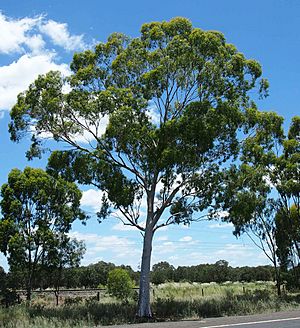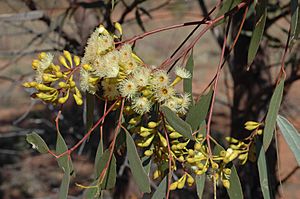Eucalyptus thozetiana facts for kids
Quick facts for kids Eucalyptus thozetiana |
|
|---|---|
 |
|
| Eucalyptus thozetiana near Emerald | |
| Scientific classification | |
| Genus: |
Eucalyptus
|
| Species: |
thozetiana
|
| Synonyms | |
|
|
The Eucalyptus thozetiana is a type of tree found in the dry, inland parts of north-eastern Australia. It is also known as the Thozetiana Gum. This tree usually has smooth bark. Sometimes, it has rough bark near its base. It grows long, narrow leaves. Its flowers are white and grow in small groups. After flowering, it produces interesting urn-shaped or barrel-shaped fruits.
Contents
What Does the Thozetiana Gum Look Like?
The Eucalyptus thozetiana is a tree that can grow up to 17 meters (about 56 feet) tall. It often has smooth bark that is creamy white and grey. Sometimes, you might see rough, dark bark near the bottom of its trunk.
Young plants have square stems. Their leaves are long and thin, about 35 to 160 mm (1.4 to 6.3 inches) long. Adult leaves are shiny green on both sides. They are shaped like a spear, about 50 to 140 mm (2 to 5.5 inches) long.
The tree's flower buds grow in groups of seven, nine, or eleven. These groups are found at the ends of the branches. Each bud is pear-shaped or oval. They are about 4 to 6 mm (0.16 to 0.24 inches) long.
The Thozetiana Gum has white flowers. It usually flowers between March and November. After the flowers, the tree produces woody fruits. These fruits are shaped like an urn, barrel, or cylinder. They are about 3 to 5 mm (0.12 to 0.2 inches) long.
How Did It Get Its Name?
Scientists give plants special names so everyone knows exactly which plant they are talking about. The Eucalyptus thozetiana was first mentioned in 1883 by a scientist named Ferdinand von Mueller. He thought it might be a new type of Eucalyptus gracilis.
He suggested it should be named after Anthelme Thozet. Mr. Thozet was a botanist who explored plants in Australia. Sadly, he passed away during one of his plant journeys.
Later, in 1903, another scientist named Joseph Maiden described this tree more formally. He called it Eucalyptus calycogona var. thozetiana. Then, in 1906, Richard Thomas Baker decided it was different enough to be its own species. He officially named it Eucalyptus thozetiana. The name thozetiana honors Anthelme Thozet.
Where Does the Thozetiana Gum Grow?
The Eucalyptus thozetiana prefers to grow in sandy soils. You can find it in woodlands and open forests. It is common in a wide area of Queensland, Australia. This includes places like Emerald, Junda, and the Darling Downs. It also grows in the southern part of the Northern Territory, near Arltunga.
Is It Endangered?
The conservation status of a plant tells us how common or rare it is. The Queensland Government says the Eucalyptus thozetiana is of "least concern." This means it is not currently at risk of disappearing.
However, in the Northern Territory, it is listed as "near threatened." This means that while it's not in immediate danger, its numbers could become low in the future if conditions change.


